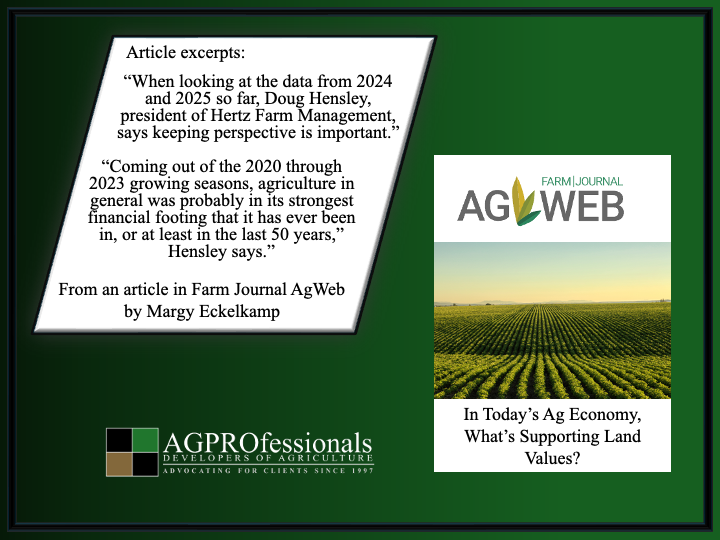“When looking at the data from 2024 and 2025 so far, Doug Hensley, president of Hertz Farm Management, says keeping perspective is important.
“Coming out of the 2020 through 2023 growing seasons, agriculture in general was probably in its strongest financial footing that it has ever been in, or at least in the last 50 years,” Hensley says.
He says 2024’s farmer income was kept afloat by the ECAP payments along with stronger markets in January and February in the early months of this year.
“A lot of people had a little bit of profit and are fighting to see another day, and out in the countryside right now, it’s not a perfect crop everywhere, but holy buckets, I mean it’s going to be a big crop, if we finish this thing,” Hensley says.
Hensley will be watching crop conditions through pollination — particularly in the next three weeks.
Hensley says this past fall, land values dipped with lower commodity prices, higher interest rates, and higher input prices challenging profitability.
“With the early ‘25 rallying commodity prices and the ECAP payments really supporting cash flow out in the countryside, we actually saw a little bump in the land market this spring,” he says. “This I would attribute to the fact that very few farms have sold.”
Regarding the lower availability of farmland for sale, Hensley says it can be attributed to human behavior.
“Anytime you get one of these geopolitical environments where there’s lots of things going, tariffs, and just the transition to the new Trump administration, it unsettled a lot of things,” he says. “And when there’s lots of uncertainties, people have a tendency, especially with big assets, just to hold off on making decisions. That’s what actually supported the land market.”
What About Land Available for Sale Through the End of the Year?
Hensley says going forward, sellers might make more land available on the market.
“I think we’re going to see volume in the land market increase, probably every month from now through harvest,” Hensley says. “So it’ll be an interesting harvest season and end of summer, but right now I think the land market looks pretty good.”
Randy Dickhut with Ag Economic Insights is watching the share of farmland purchases financed by debt. He reports an increasing share using debt for purchase, mostly notable in Indiana but also Iowa and Illinois showing an increase as well.
“This isn’t surprising given strong farmland values and sluggish farm income, especially for corn and soybean producers,” he says.
Dickhut breaks down the commonly referenced statistic that 85% of farmland is debt-free, and he highlights how now that number is closer to 80% in Iowa at a statewide level. The level of debt-free farmland varies across the five state he analyzed, Iowa, Illinois, Indiana, Ohio, and Minnesota, where an average of 27% of farmland sales between 2021 and 2024 reported a lien.
His analysis underscores how land and debt are critical parts of the farmer’s balance sheet as real estate accounts for 84% of farm assets and 67% of all farm debt.
“However, farm incomes have been quite volatile over the last few years,” Dickhut says. “As such, it stands to reason that debt might be more common in 2024 than in 2021 or 2022.”
And from his analysis, across Indiana, Illinois and Iowa, the share of land sales using a loan was higher in 2024 than any other earlier year reported.
From the Chicago Federal Reserve ag banker survey, other results included:
- 69% of the surveyed bankers expect farmland prices to be unchanged in the second quarter of 2025
- Annual cash rents declined across the district for the first time since 2020
- This year, average annual cast rents dropped 3% in Iowa, dropped 2% in Illinois and went up 1% in Indiana
- No banker in the survey observed higher rates of loan repayment in the first quarter, compared to Q1 2024
- 39% reported lower rates of repayment by their farm customers
- On average, 19% of their farm borrowers (still a small percentage) had more carryover debt from last year’s crop carried over into the new growing season, compared to the amount of carryover debt one year ago”
Link to article HERE:

